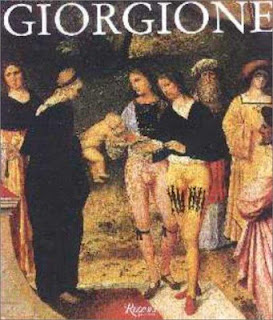In their 1999 Giorgione catalog Terisio Pignatti and
Filippo Pedrocco made a valiant attempt to not only attribute and interpret the
paintings of Giorgione, but also to present them in a rough chronological
order.*
The dust jacket of the catalog noted that Teriseo
Pignatti made his career at the Civic Museum of Venice since 1945, and that he
became director of the Museum in 1974. Filippo Pedrocco had overseen the Museum
of Settecento Veneziano in Ca’ Rezzonico since 1983. It would be hard to
imagine two more distinguished Italian scholars.
In the next few months I would like to present the
works of Giorgione in the order in which Pignatti and Pedrocco presented them knowing that
there will always be disagreement on matters of attribution, interpretation,
and dating when it comes to Giorgione.
In today’s posting I list the first four entries in
the catalog. These four small similar panel paintings all seem to have been
made for a small box.
We support the argument that the Padua panels—and the others that make up this series—were originally part of a decorative scheme for a piece of furniture or a jewel box.(p. 92)
I use the titles preferred by the authors.
1. Rustic Idyll, Panel, 12 x 19 cm, Padua, Museo
Civico.
2. Leda and the Swan, Panel, 12 x 19 cm, Padua,
Museo Civico.
3. The Astrologer (Orpheus and Time), Panel, 12 x
19.5 cm, Washington, Phillips Memorial Gallery.
4. Venus and Cupid in a Landscape, Panel, 11 x 20
cm, Washington, National Gallery of Art.
The authors agree with those who believe that these
panels are the earliest known works of Giorgione.
Number 1 depicts three figures in a landscape. Since
I interpreted Giorgione’s Tempest as his version of the “Rest of the Holy
Family on the Flight into Egypt,” I suspected that the “Rustic Idyll” might
have been an early attempt at that subject. However, recent attempts to
attribute the “Malmesbury” version of the “Judgment of Paris” to either
Giorgione or Raphael have made me wonder if the man in the Rustic Idyll might
also be Paris since the attire of both is so similar. In that case the “Rustic
Idyll” would represent the story of Paris, the nymph Oenone, and their young
child.
Number 2 is the only one of the four with an obvious
subject. However, in her study of Venetian humanism Margaret King has shown
that even the rape of Leda by Jove in the guise of a swan could have a
Christian meaning. No one has ever been able to identify the woman holding up a
strange mirror.
Number 3 depicts two figures in a landscape. The
authors believe that the Astrologer title is not pertinent and believe that an
hypothesis suggesting Orpheus and Father time is “more credible.”
Number 4. The authors note that this panel might
have been the front of the box since x-rays reveal a keyhole in the center.
Most accept the identification of Venus and Cupid but I wonder if the long red
hair of the woman could make her the penitent Mary Magdalen in the wilderness
being ministered to by an angel. ###
Edit: In his 2007 catalog Wolfgang Eller argued that none of the four panels exhibited enough quality to be by Giorgione and that they were most likely done around 1520 or 1525. He felt that the quality was so poor that they couldn't even be attributed to Giulio Campagnola.**
However, In his 2009 study of Giorgione done in connection with the exhibition in Padua celebrating the 500th anniversary of the death of Giorgione, Enrico Maria dal Pozzolo attributed #1 and #2 (coincidentally now in Padua) to Giorgione but believed that #3 and #4 were by an associate working with Giorgione. He supports an early dating.***
Edit: In his 2007 catalog Wolfgang Eller argued that none of the four panels exhibited enough quality to be by Giorgione and that they were most likely done around 1520 or 1525. He felt that the quality was so poor that they couldn't even be attributed to Giulio Campagnola.**
However, In his 2009 study of Giorgione done in connection with the exhibition in Padua celebrating the 500th anniversary of the death of Giorgione, Enrico Maria dal Pozzolo attributed #1 and #2 (coincidentally now in Padua) to Giorgione but believed that #3 and #4 were by an associate working with Giorgione. He supports an early dating.***
*Pignatti, Terisio, and Pedrocco, Filippo: Giorgione, Rizzoli, NY, 1999.
**Eller, Wolfgang: Giorgione Catalog Raisonne,
Petersberg, 2007.
***Dal Pozzolo, Enrico Maria: Giorgione, Milan, 2009.






In "Leda and the Swan" (Number 2) the lady is almost certainly Peitho, the goddess of "persuasion", and attendant to Aphrodite. See, eg, https://www.theoi.com/Daimon/Peitho.html, where she is shown on a classical piece of pottery with the same odd mirror. The work, sometimes attributed to the "School of Giorgione", then poses questions about the source of this instance of the theme of Peitho as welcoming the "intimacy" of Leda and Zeus. Leda was probably feeling down in the mouth. Greg Bird
ReplyDeleteThanks for reading. I am not familiar with Peitho and appreciate the comment despite the gratuitous last sentence.
Delete